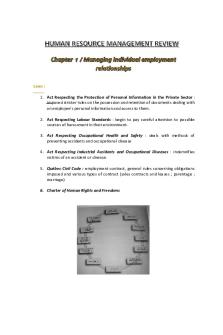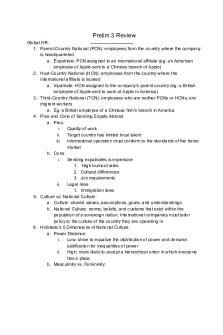HRM Test 1 Review - Summary Human Resources Management PDF

| Title | HRM Test 1 Review - Summary Human Resources Management |
|---|---|
| Author | Brinean Crews |
| Course | Human Resources Management |
| Institution | Georgian College |
| Pages | 7 |
| File Size | 63.6 KB |
| File Type | |
| Total Downloads | 34 |
| Total Views | 129 |
Summary
Review for first three chapters...
Description
HRM Test Review What is the role of a HR manager?
To be able to process and manage human talent to achieve an organization objectives, analyzing company’s competitive environment and designing job so that a firm’s strategy and be successfully implemented to beat the competitions; recruitment, labour relations, etc… Business mastery – know the business of their organization thoroughly, economic and financial capabilities, become key member of team to develop firms strategic direction, develop skills at external relations focused on customers; business acumen, customer orientation, external
relations HR mastery – organization’s behavioral science experts, should develop knowledge in the areas of staffing, development, appraisals, rewards,
team building, and communication; staffing, performance appraisal, rewards system, communication, organization design Change mastery – manage change processes so that firms’ HR activities are effectively merged with business needs of organization, interpersonal and problem-solving skills, innovativeness and creativity; interpersonal
skills and influence, problem-solving skills, rewards system, innovativeness and creativity Personal credibility – must establish credibility in eyes of internal and external customers, earned by developing personal relationships with
customers, demonstrating values of the firm, standing up for one’s own beliefs, and being fair-minded when dealing with others; trust, personal relationships, lived values, courage Advice and counsel, service, policy formations and implementation, employee advocacy
Difference between blue collar and white collar / manual labour vs. knowledge worker Blue Collar – physical laborers White Collar – non-physical labour/office workers Manual Labour – physical labour already expected Knowledge workers – responsibilities extend beyond physical execution of
work; planning, decision making, and problem solving What are organizational core values? Beliefs and principles that the company uses as a foundation for its decisions
How does HR work in a competitive environment?
Responding strategically to changes in the local and global marketplace Setting and achieving corporate social responsibility and sustainability
goals Advancing HRM with technology
Containing costs while retaining top talent and maximizing productivity Responding to the demographic and diversity challenges of the workforce Adapting to educational and cultural shifts affecting the workforce
What’s the concept of trend analysis?
Forecasting labour demand based on an organizational index (such as sales)
Concentration of a segregated marketed? i.e. females in nursing Women concentrated into occupations that are accorded lower status and
pay underrepresented as semiprofessionals and technicians, supervisors in
trades and natural and applied sciences, management positions/members of boards ensure equal treatment, and advancement opportunities and compensation
What are the benefits of diversity?
Better utilization of talent; increased marketplace understanding; enhanced creativity; increased quality of team problem solving; greater understanding in leadership positions
Employment equity process
The employment of/treatment of employed individuals in a fair and nonbiased manner; 4 designated groups: women, aboriginal people, visible minorities, people with disabilities; organizations regulated under Canada Labour code; applies to companies w/ >100 employees and federal contractors program
Understanding pay equity illegal to discriminate on the basis of job content; equal pay for work of equal value Purpose of HR forecasting to better prepare the organization and meet its future needs; managing labour supply and demand
Methods of internal HR forecasting forecasting demand for employees: trend analysis, managerial estimates,
Delphi technique forecasting supply of employees: staffing tables, Markov analysis, skills inventories, management inventories, replacement charts, succession planning
Methods to deal with labour surplus layoffs: based on seniority and/or ability, work reduction (reduced
workweek/shifts, transfers), fastest way to receive workforce reduction attrition: natural departure of employees through quits, retirements, &
death, hiring freezes, termination: based on performance, cannot terminate without severance pay (minimum standards determined in the employment standards act)
Designated groups in employment equity women, aboriginal people, visible minorities, people w/ disabilities; protected from mistreatment Concept of corporate social responsibility (CSR)
the responsibility of the firm to act in the best interests of the people and
communities affected by its activities closely related to sustainability, company’s ability to produce a good or service w/o damaging the environment/depleting resources
Concept of environmental scanning systematic monitoring of the major external forces influencing the organization (economic & ecological; technological; demographic; social; legal and regulatory) Family friendly benefits/policies more family friendly options, implementing policies like; telecommuting, child care, flexible work hours, job sharing, mat/pat leave, shorter work weeks Understanding human rights and equity legislation Concept of mission statements a statement featuring the basic purpose of the organizations as well as its scope of operations
HR data analysis important part of employment equity planning stock data: provide a snapshot of the organization, show where members of designated groups are employed in the organization, at what salaries
and status, and in what occupations on a particular date flow data: the distribution of designated groups in applications, interviews, hiring decisions, training and promotion opportunities, and termination. Provide information on the movement of employees into and through the organization.
Employee core capabilities Concept of mission, vision, and values Mission – basic purpose of the organization as well as its scope of operations
Strategic Vision – a statement about where the company is headed and
what it can become in the future; clarifies the long-term direction of the company and its strategic intent Core Values – the strong and enduring beliefs and principles that the company uses as a foundation for its decisions
Reasons for system/systemic discrimination The exclusion of members of certain groups through the application of employment policies or practices based on criteria that are not job related Concept of a balanced scorecard A measurement framework that helps managers translate strategic goals into operational objectives (financial, customer, processes, learning) Understanding purpose of HRIS systems A computerized system that provides current and accurate data for
purposes of control and decision making Becoming a potent weapon for lowering administrative costs, increasing productivity, speeding up response times, improving decision making, and tracking talent
Concept of skill inventories Files of personnel education, experience, interests, and skills that allow managers to quickly match job openings with employee backgrounds
Concepts of outsourcing and offshoring Both methods of reducing number of employees Outsourcing – contracting outside organization to have work done that
formerly was done by internal employees Offshoring – the business practice of sending jobs to other countries
Understanding applications of seniority Using seniority to make decisions regarding layoffs benefits workers who aren’t achieving as much just because they’ve been there longer, but it does provide an objective measure to make decisions with
Quality systems and Six Sigma A set of principles and practices whose core ideas include understanding customer needs, doing things the right the first time, and striving for continuous improvement Severance pay and termination pay
Severance pay – lump sum payment given to separate an employee from an organization permanently, must have worked there more than 5 years, (amount made per week)(years worked) = total payment
Termination pay – payment in lieu of notice of termination, must also pay out benefits
Concept of benchmarking The process of comparing the organization’s processes and practices to those of other companies Concept of HR stock data A method of data collection and analysis Data showing the status of a designated groups in occupational categories and compensation levels How regulatory systems/laws are enforced? Human Rights laws: file a written complaint, investigation and submission of report, if complains is substantiated –settlement, if not –then a tribunal
Definition/application of strategic planning Procedures for making decisions about the organization’s long-term goals
and strategies Human Resource Planning (HRP) – the process of anticipating and providing for the movement of people into, within, and out of an
organization Strategic Human Resource Management (SHRM) – the patter of human resources deployments and activities that enable an organization to
achieve its strategic goals Understanding/analysis of supply and demand of labour Demand considerations based on forecasted trends in business activity,
supply considerations involve determining where and how candidates with the required qualifications can be found to fill vacancies Staffing options to meet HR demands: hiring full-time employees, overtime, recall laid-off workers, using temporary or contract employees, outsourcing or offshoring business processes
BFOR Bona Fide Occupational Requirement Positives and negatives of joint ventures/mergers/acquisitions Positives: allow for growth and diversification of workforce and customers Negatives: cultural inconsistencies, conflicts among the managers of each firm Markov analysis A method for tracking the pattern of employee movements through various jobs Purpose/value of cultural audits Audits of the culture and quality of work life in an organizations Can help the firm decide on the strategic investments necessary to build and sustain a culture; can determine if the culture of two companies will complement each other in a merger Balancing role of HR/who do they support? ...
Similar Free PDFs

Paper Human Resources Management
- 1 Pages

ASSIGNMENT 1 HUMAN RESOURCES
- 7 Pages

Human Resource Management Review
- 40 Pages
Popular Institutions
- Tinajero National High School - Annex
- Politeknik Caltex Riau
- Yokohama City University
- SGT University
- University of Al-Qadisiyah
- Divine Word College of Vigan
- Techniek College Rotterdam
- Universidade de Santiago
- Universiti Teknologi MARA Cawangan Johor Kampus Pasir Gudang
- Poltekkes Kemenkes Yogyakarta
- Baguio City National High School
- Colegio san marcos
- preparatoria uno
- Centro de Bachillerato Tecnológico Industrial y de Servicios No. 107
- Dalian Maritime University
- Quang Trung Secondary School
- Colegio Tecnológico en Informática
- Corporación Regional de Educación Superior
- Grupo CEDVA
- Dar Al Uloom University
- Centro de Estudios Preuniversitarios de la Universidad Nacional de Ingeniería
- 上智大学
- Aakash International School, Nuna Majara
- San Felipe Neri Catholic School
- Kang Chiao International School - New Taipei City
- Misamis Occidental National High School
- Institución Educativa Escuela Normal Juan Ladrilleros
- Kolehiyo ng Pantukan
- Batanes State College
- Instituto Continental
- Sekolah Menengah Kejuruan Kesehatan Kaltara (Tarakan)
- Colegio de La Inmaculada Concepcion - Cebu












